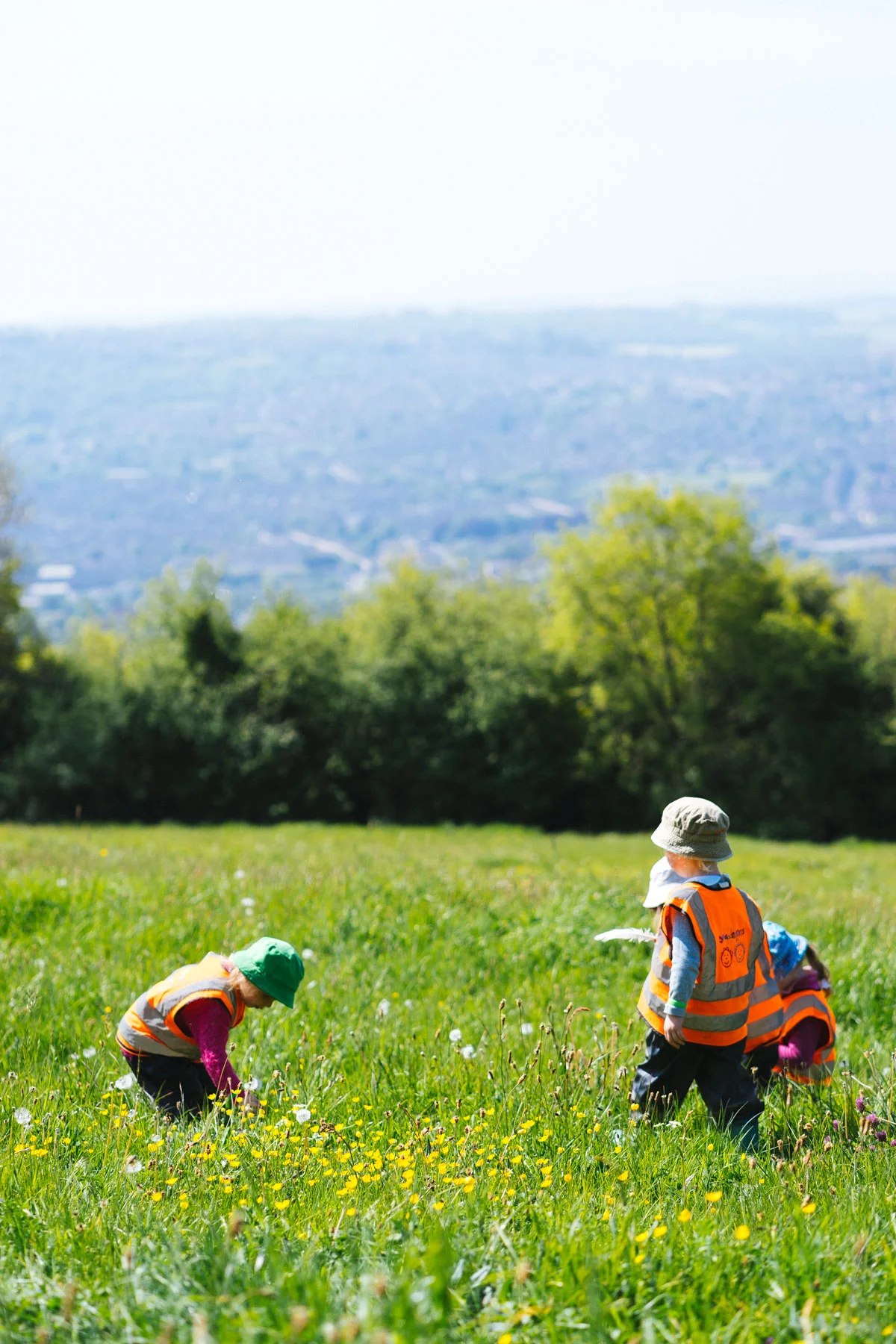
Ten Stick
On a training course in Cornwall this Summer I had the great opportunity to have a masterclass in outdoor Maths by Juliet Robertson (her Messy Maths book is out now); ideas, tips, games and activities filled the 45 minute session and left me with a long list of things to introduce into my practice.
The first thing I did when I got back home was to take one of my hazel walking sticks (yes I have several) , saw the top off to make it a metre long and then cut notches every ten centimetres. This transformed a once ordinary pole into THE TEN STICK!!
What does it do you ask?
It measures the length of flowers, grasses, trees and other sticks when we need things to be a certain length. It tells us the depth of a puddle so we know if it will come over our wellies. When we put things next to the notches it tells us how many things we have collected and spaces them out so it's easier to count them. It can even tell us the circumference of a tree if we wrap some string around it first and then lay it flat. The first time the ten stick came on a walk it even worked as a (wait for it) WALKING STICK to show who the leader was of the group!
The ten stick provides a simple way to measure amounts for young children and helps them to understand amounts in a visual and tactile way. It now accompanies me out of most forest school sessions and it always gets used.
Not bad for a bit of hazel...
P.S The next time you're in a woods try this simple way of measuring how tall a tree is!
When nothing is more than enough
Before heading out on any Forest School trip I look around my workshop and think "what will I need?" I have planned activities which require certain items but I also have my continuous provision which can be brought out to facilitate a range of interests shown by the children.
There's normally string, cord, scissors, knives, collecting pots, binoculars, magnifying glasses, cloth, paper and crayons ready for when a child shows an interest so that I can help them develop their ideas and engage with their interests.
Just before a walk through Primrose Hill Community Woodland recently with preschool children from Grosvenor I was looking around but instead of packing my usual pieces I thought "Let's see what happens when I take nothing", no extra items, no forest school backpack, no extra weight apart from the grab bag that accompanies us on every trip.
What happened instead was one of the most enjoyable trips possible. Rather than thinking constantly about how to extend each child's interest using extra items we focussed purely on what was around - sticks to make bug and fairy homes or to make arrows that directed us around the woods, charcoal from recent fires for drawing on trees. Dandelion clocks whose seeds are perfectly designed to float away on the lightest breath of wind were spread far and wide by the group who also investigated the wide range of meadow flowers on the hill; buttercups, plantain, lady's smock, herb robert and daisies to name just a few. Moreover there was the geography of the walk, climbing upwards, upwards and upwards right to the summit was a challenge the the group were more than up for, one girl even carried up three large rocks that she had found in the woods.
Eventually we reached the top and the view out across the surrounding landscape couldn't have been more rewarding. It was a session where I took nothing but everything came together perfectly.
The Dawn Chorus
The alarm goes off every morning at 5:30. Not my work alarm but the first early call of the Robin replacing the silence left by the few steady Owl hoots at 3am. The Robins are overshadowed and outshone by the deeper, throatier call of the Blackbirds closer to the window, and then at 6 o'clock, near enough on the dot, the Wren starts, its machine gun cry covers everything around - impressive for a bird that looks like a feathered ping pong ball. Steadily as the sun comes up the winged world starts to warm up its vocal chords - Blue, Long-tailed and Great Tits and Goldfinches are the most common where I live but around the nurseries there are always different calls and songs to hear.
If you head to Corsham and Broadwood the Sparrows chatter-chatter in the hedge along the bottom of the garden, over at Grosvenor and Horfield there are Starlings whistling and clicking from the tops of the buildings, Keynsham has its own brave Robin who has been known to hop indoors to see what's going on and Weston is home to several Great Tits who call out "teacher, teacher". At the top of Atworth's thick cypress hedge are Blackbirds getting a good view of the surrounding area and over at Shirehampton Blue Tits cry shrilly in between the branches of the young trees in their forest garden.
This time of year is a perfect opportunity to release your inner twitcher as the song and chorus will be increasing in volume and length before the mid summer hush when the birds are nesting. It's not about being able to spot and name every creature around but to notice patterns and place where you hear the same calls. For example, whenever I take a group to the woods I ask everyone to walk in as quietly as they can and to listen carefully. Quickly the children notice the bird calls right around them. These calls are an alarm system that will echo through the trees as more birds respond to the alarm and pass on the message further and further. Steadily, as the woods become used to us being there the calls will settle and the birds will carry on with their lives. Next time you're in the woods, try and spot the point when the birds start calling and when they stop.
On May 7th it is International Dawn Chorus Day which celebrates this natural phenomenon. All over the world people will be getting up early to hear the birds so if you find yourself awake, go to a window, close your eyes and listen.
Natural Objects To Spark The Imagination
The way an activity is presented to the children has a powerful impact on its potential for learning. Skilled adults provoke children's interest and curiosity through the way they set up resources. This invites children in, leading them to become engaged and motivated, with opportunities to extend their thinking.
Initially a house was made with sticks, which then sparked her own recall of the snake’s log pile house from “The Gruffalo”.
A child entered into this activity, tempted in through the adult’s arrangement of a tree with bark and leaves, and a bird using circles of wood and sticks for a beak and legs. This was rooted in the children's interest in the different birds from our recent story focus of “Chicken Licken”.
As a variety of natural objects are available for exploration, presented in baskets for the children to select freely, this enabled her to build upon and develop her own ideas in the following ways.
Leaves were used for the fox’s den, it was important to her to provide him with some of these leaves to use as a blanket.
The owl’s house was created using bark pieces placed to form a large tree with spreading branches.
Shiny stones were selected and lined up to mark out the mouse house. Then finally, pine cones were carefully arranged for the Gruffalo’s cave, complete with a piece of bark stood up as his door.
The owl’s house was created using bark pieces placed to form a large tree with spreading branches.
These natural loose parts had been used by the child to create a complete story environment. A toy mouse could then explore and visit each of the character’s homes, retelling the story in her own way.
From an inspiring starting point, ideas evolved through the child’s own story knowledge and creativity. Freedom to select and arrange these natural objects gave the control to make her own choices and decisions. The open ended nature of this activity gave her the opportunity to use objects to represent the features of a story she knows well and remain motivated through her own interests.
This activity was an effective context in which she could use her communication skills to express her ideas. Also physical and mathematical experience was gained through manipulating and arranging the objects carefully. Access to this variety of natural materials also increases understanding of the world around us.
All this learning and imagination from such simple resources, and so much fun!
The Kitchen Garden
Whether or not you're a gardener you'll have noticed in the last couple of weeks that nature is waking up and springing into action after a long, dark winter. In the nurseries the grass that has been trampled into oblivion by hundreds of mini wellies over the wet winter is beginning to recover and is already looking more green than brown.
Flower borders littered with clumps of brown, rotted leaves and dry-looking twigs are suddenly reminding us of their potential as they push up fresh green growth. Spring has sprung!
In our vegetable growing areas we are starting to plan which edible plants to grow. We're looking for plants that will inspire the children with incredible colours, smells and textures. We want to instil in them a love of fresh food in all its glory. There's nothing more guaranteed to encourage children to try new tastes and textures of fruit and vegetables than helping to grow them.
At Snapdragons Keynsham, Tim "don't-fence-me-in" Graham, our Leader of Outdoor Learning (#LOL), has been hard at work plotting out the vegetable patch and we're excited to reap the rewards. We have focussed on growing a variety of edible plants that are packed with sensory benefits - plants that smell amazing, look great, feel interesting and taste wonderful. On top of that, we've looked for plants that attract bees and other native wildlife to encourage a diverse and sustainable environment. We invited the Keynsham grandparents to help us plant up the kitchen garden and they didn't disappoint, sharing their love of growing with their grandchildren and helping to inspire the next generation of horticulturalists.
Over the next few weeks, we'll be watching the progress of our nursery gardens and looking to use the produce in our new Nursery Kitchen video feature. So if you've been inspired to get planting, we hope to give you some ideas of how to use your home-grown food. Let's get cooking!























